Page 253 of 337
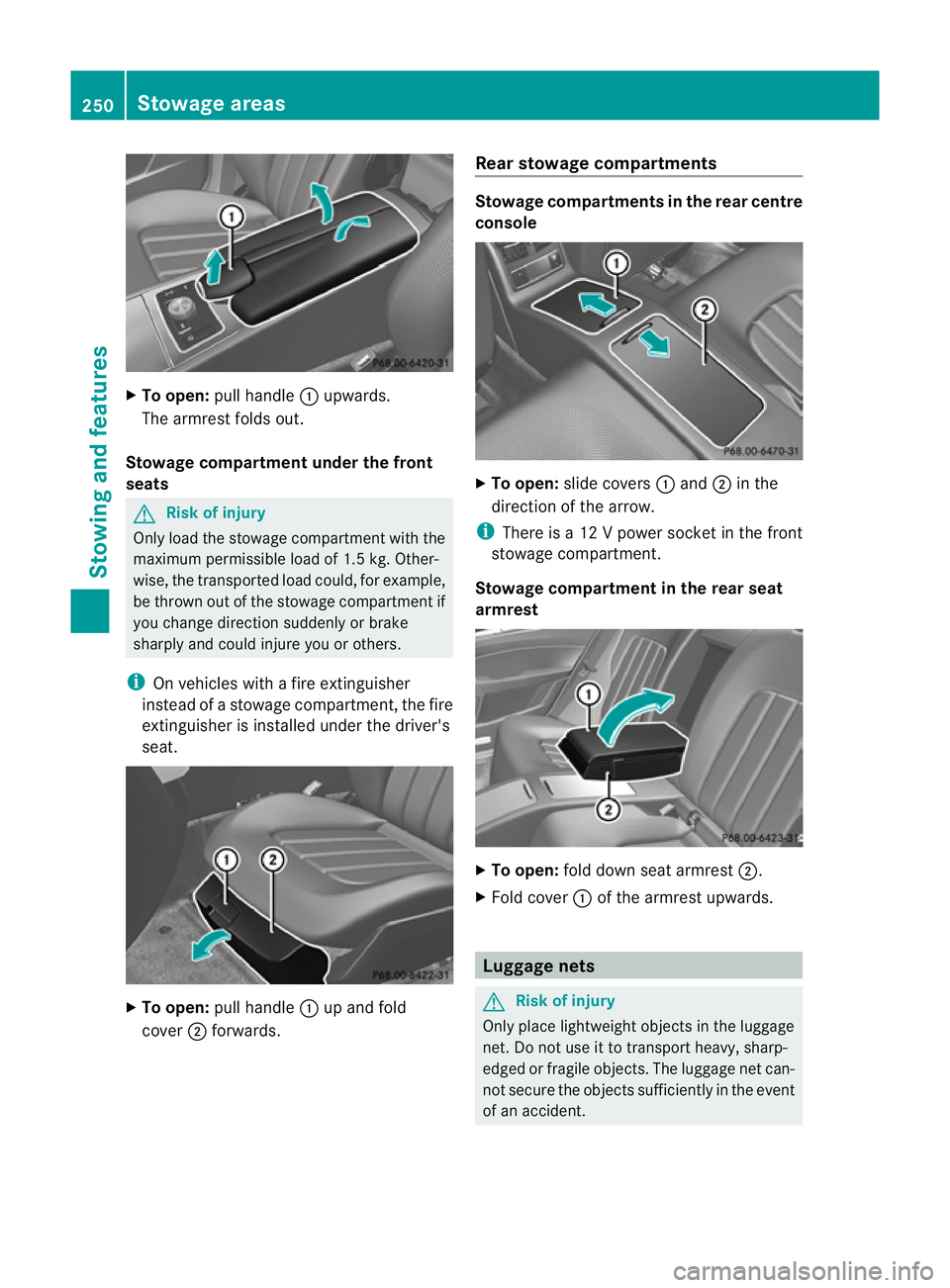
X
To open: pull handle :upwards.
The armrest folds out.
Stowage compartment under the front
seats G
Risk of injury
Only load the stowage compartment with the
maximu mpermissible load of 1.5 kg. Other-
wise, the transported load could, for example,
be thrown out of the stowage compartment if
you change direction suddenly or brake
sharply and could injure you or others.
i On vehicles with a fire extinguisher
instead of a stowage compartment, the fire
extinguisher is installed under the driver's
seat. X
To open: pull handle :up and fold
cover ;forwards. Rear stowage compartments Stowage compartments in the rear centre
console
X
To open: slide covers :and ;in the
direction of the arrow.
i There is a 12 V power socket in the front
stowage compartment.
Stowage compartment in the rear seat
armrest X
To open: fold down seat armrest ;.
X Fold cover :of the armrest upwards. Luggage nets
G
Risk of injury
Only place lightweight objects in the luggage
net. Do not use it to transport heavy, sharp-
edged or fragile objects. The luggage net can-
not secure the objects sufficiently in the event
of an accident. 250
Stowage areasStowing and features
Page 298 of 337
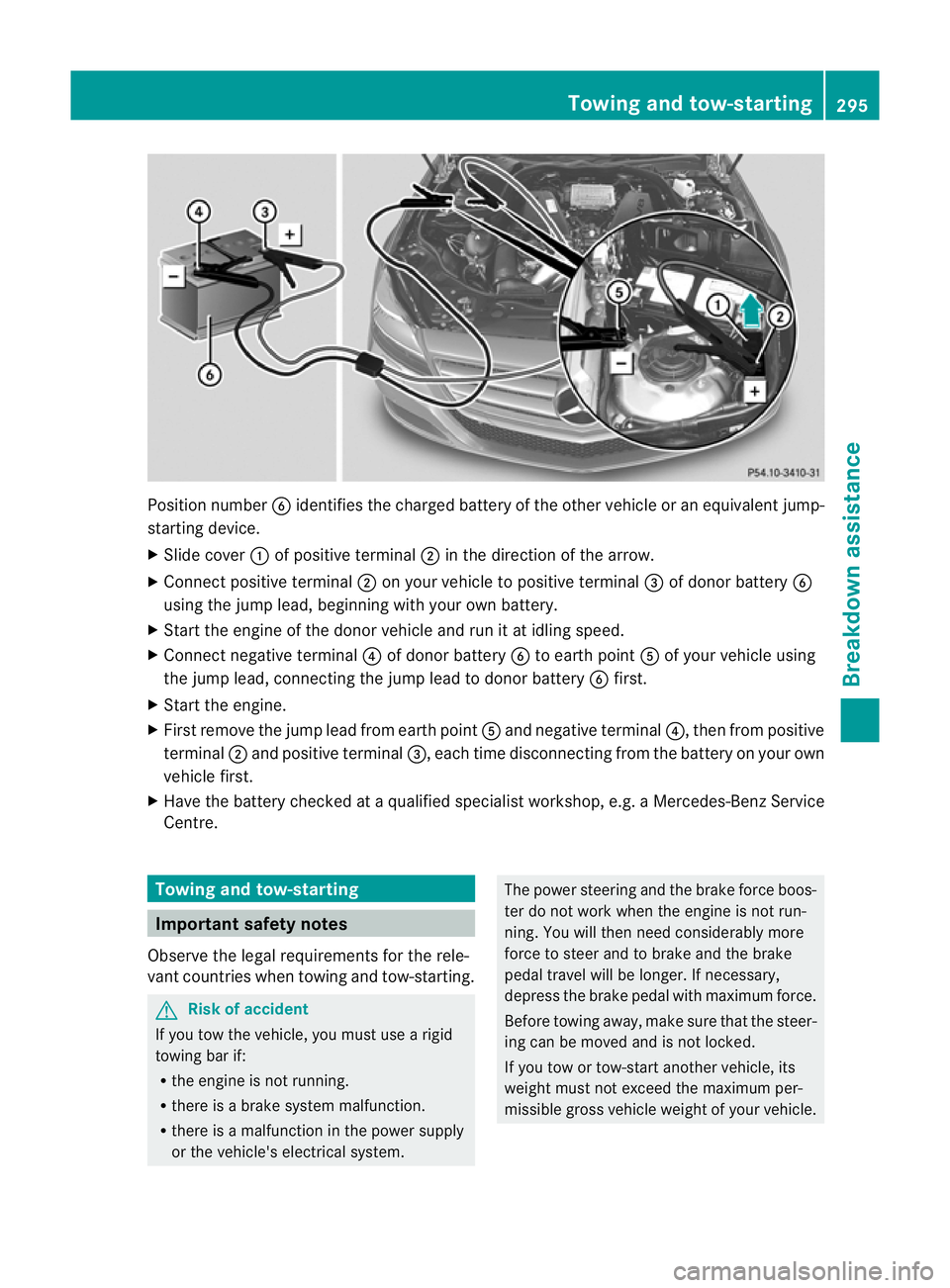
Position number
Bidentifies the charged battery of the other vehicle or an equivalent jump-
starting device.
X Slide cover :of positive terminal ;in the direction of the arrow.
X Connec tpositive terminal ;on your vehicle to positive terminal =of donor battery B
using the jump lead, beginning with your own battery.
X Start the engine of the donor vehicle and run it at idling speed.
X Connect negative terminal ?of donor battery Bto earth point Aof your vehicle using
the jump lead, connectingt he jump lead to donor battery Bfirst.
X Start the engine.
X First remove the jump lead from earth point Aand negative terminal ?, then from positive
terminal ;and positive terminal =, each time disconnecting from the battery on your own
vehicle first.
X Have the battery checked at a qualified specialist workshop, e.g. a Mercedes-Ben zService
Centre. Towing and tow-starting
Important safety notes
Observe the legal requirement sfor the rele-
vant countries when towing and tow-starting. G
Risk of accident
If you tow the vehicle, you must use a rigid
towing bar if:
R the engine is not running.
R there is a brake system malfunction.
R there is a malfunction in the power supply
or the vehicle's electrical system. The power steering and the brake force boos-
ter do not work when the engine is not run-
ning. You will then need considerably more
force to steer and to brake and the brake
pedal travel will be longer. If necessary,
depress the brake pedal with maximum force.
Before towing away, make sure that the steer-
ing can be moved and is not locked.
If you tow or tow-start another vehicle, its
weight must not exceed the maximum per-
missible gross vehicle weight of your vehicle. Towing and tow-starting
295Breakdown assistance Z
Page 321 of 337
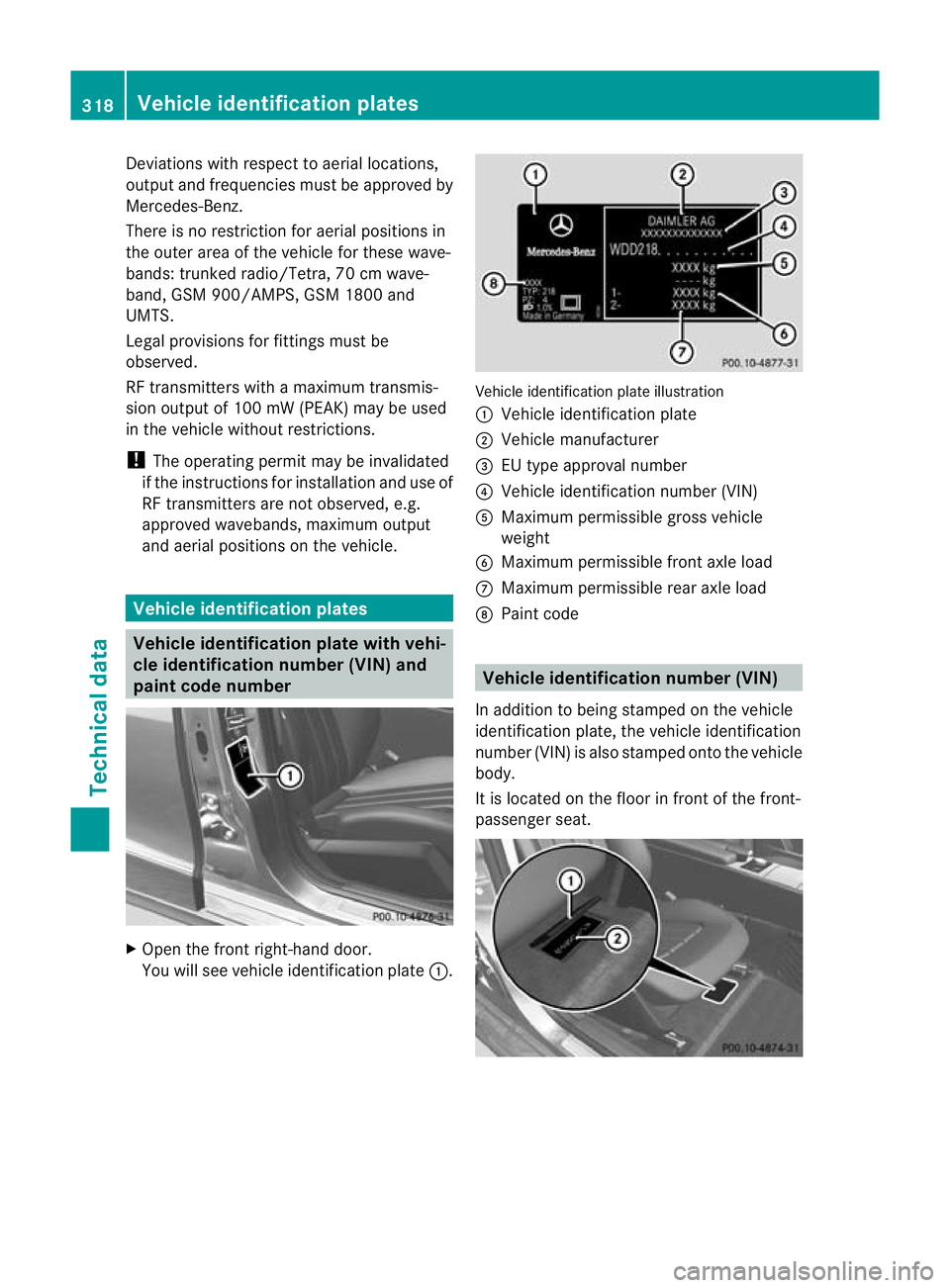
Deviations with respect to aerial locations,
outpu
tand frequencies must be approved by
Mercedes-Benz.
There is no restriction for aerial positions in
the outer area of the vehicle for these wave-
bands: trunked radio/Tetra, 70 cm wave-
band, GSM 900/AMPS, GSM 1800 and
UMTS.
Legal provisions for fittings must be
observed.
RF transmitters with a maximum transmis-
sion output of 100 mW (PEAK) may be used
in the vehicle withou trestrictions.
! The operating permit may be invalidated
if the instructions for installation and use of
RF transmitters are not observed, e.g.
approved wavebands, maximum output
and aerial positions on the vehicle. Vehicle identification plates
Vehicle identification plate with vehi-
cle identification number (VIN) and
paint code number
X
Open the fron tright-hand door.
You will see vehicle identification plate :. Vehicle identification plate illustration
:
Vehicle identification plate
; Vehicle manufacturer
= EU type approval number
? Vehicle identification number (VIN)
A Maximum permissible gross vehicle
weight
B Maximum permissible front axle load
C Maximum permissible rear axle load
D Paint code Vehicle identification number (VIN)
In additio nto being stamped on the vehicle
identification plate, the vehicle identification
number (VIN) is also stamped onto the vehicle
body.
It is located on the floor in front of the front-
passenger seat. 318
Vehicle identification platesTechnical data
Page 326 of 337
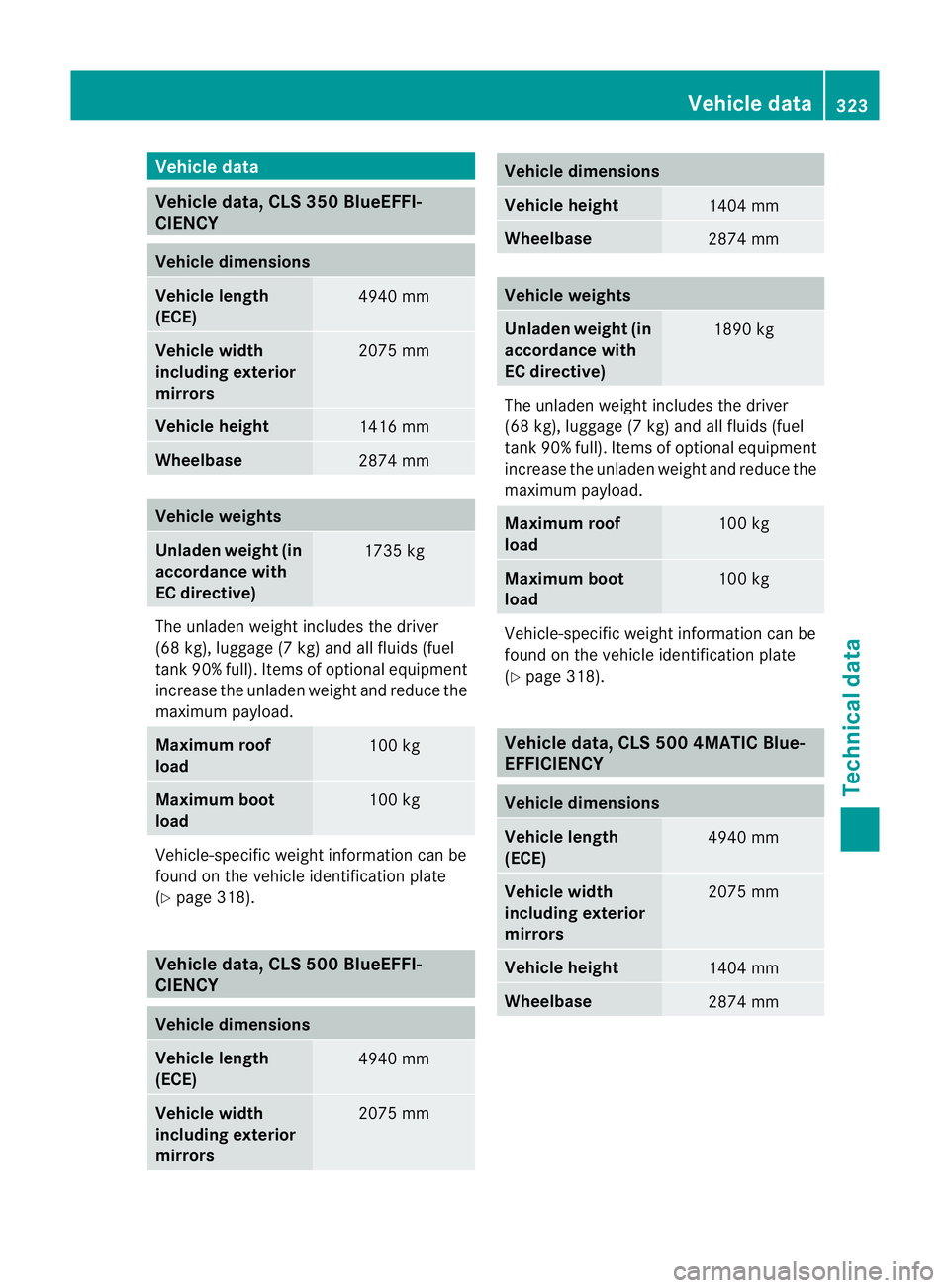
Vehicle data
Vehicle data, CLS 35
0BlueEFFI-
CIENCY Vehicle dimensions
Vehicle length
(ECE)
4940 mm
Vehicle width
including exterior
mirrors
2075 mm
Vehicle height
1416 mm
Wheelbase
2874 mm
Vehicle weights
Unladen weight (in
accordance with
EC directive)
1735 kg
The unladen weight includes the driver
(68 kg), luggage (7 kg) and all fluids (fuel
tan k90% full). Items of optional equipment
increase the unladen weight and reduce the
maximu mpayload. Maximum roof
load
100 kg
Maximum boot
load
100 kg
Vehicle-specific weigh
tinformation can be
found on the vehicle identificatio nplate
(Y page 318). Vehicle data
,CLS 500 BlueEFFI-
CIENCY Vehicle dimensions
Vehicle length
(ECE)
4940 mm
Vehicle width
including exterior
mirrors
2075 mm Vehicle dimensions
Vehicle height
1404 mm
Wheelbase
2874 mm
Vehicle weights
Unladen weight (in
accordance with
EC directive)
1890 kg
The unlade
nweight includes the driver
(68 kg), luggage (7 kg) and all fluids (fuel
tank 90% full). Items of optional equipment
increase the unladen weight and reduce the
maximum payload. Maximum roof
load
100 kg
Maximum boot
load
100 kg
Vehicle-specific weight information can be
found on the vehicle identification plate
(Y
page 318). Vehicle data, CLS 500 4MATIC Blue-
EFFICIENCY
Vehicle dimensions
Vehicle length
(ECE)
4940 mm
Vehicle width
including exterior
mirrors
2075 mm
Vehicle height
1404 mm
Wheelbase
2874 mmVehicle data
323Technical data Z
Page 327 of 337
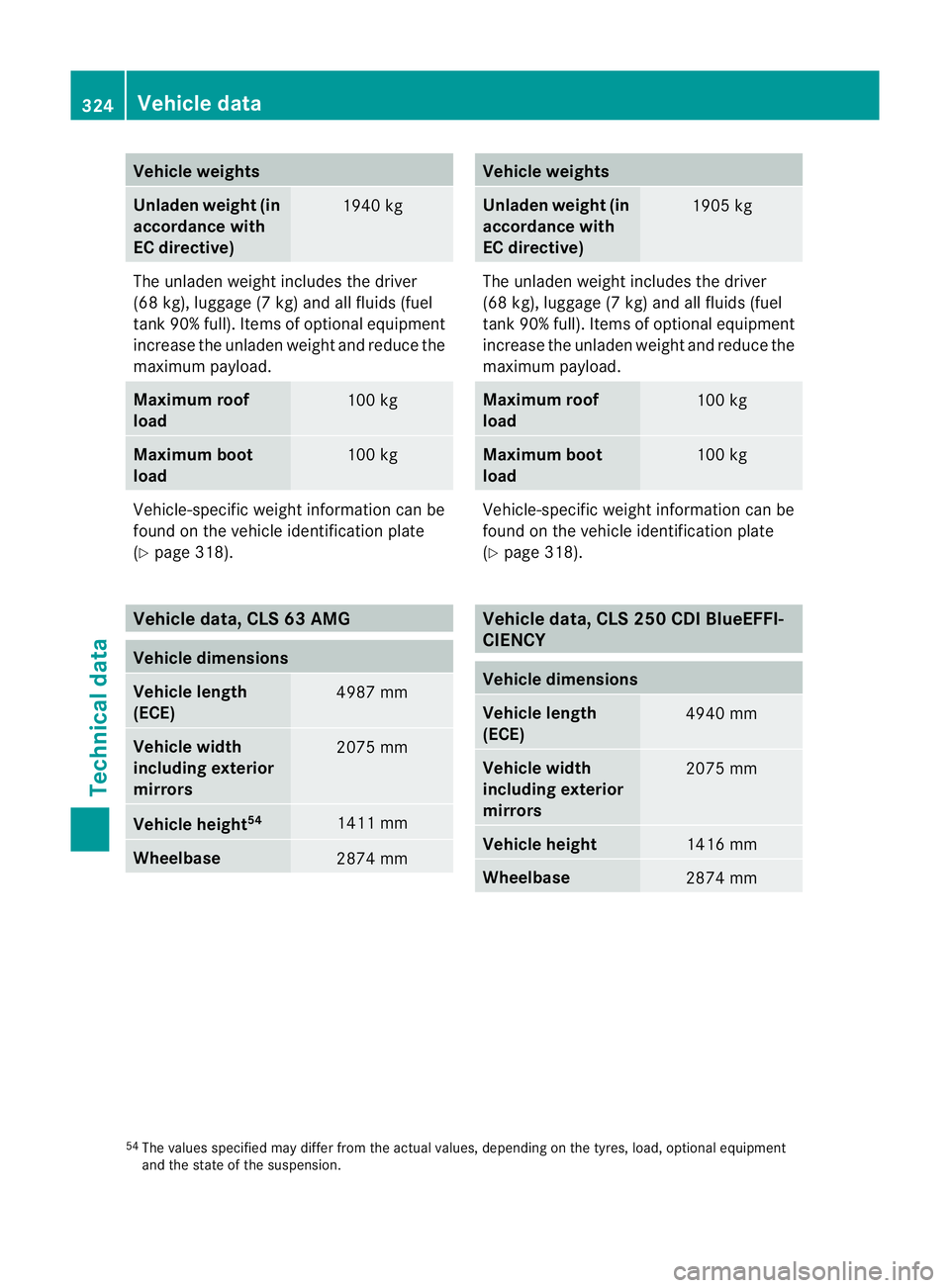
Vehicle weights
Unladen weight (in
accordance with
EC directive)
1940 kg
The unladen weight includes the driver
(68 kg), luggage (7 kg) and all fluids (fuel
tank 90% full) .Items of optional equipment
increase the unladen weight and reduce the
maximum payload. Maximum roof
load
100 kg
Maximum boot
load
100 kg
Vehicle-specifi
cweight information can be
found on the vehicle identification plate
(Y page 318). Vehicle data, CLS 63 AMG
Vehicle dimensions
Vehicle length
(ECE)
4987 mm
Vehicle width
including exterior
mirrors
2075 mm
Vehicle height
54 1411 mm
Wheelbase
2874 mm Vehicle weights
Unladen weight (in
accordance with
EC directive)
1905 kg
The unladen weight includes the driver
(68 kg), luggage (7 kg) and all fluids (fuel
tank 90% full). Items of optional equipment
increase the unladen weight and reduce the
maximum payload. Maximum roof
load
100 kg
Maximum boot
load
100 kg
Vehicle-specific weight information can be
found on the vehicle identification plate
(Y
page 318). Vehicle data, CLS 250 CDI BlueEFFI-
CIENCY
Vehicle dimensions
Vehicle length
(ECE)
4940 mm
Vehicle width
including exterior
mirrors
2075 mm
Vehicle height
1416 mm
Wheelbase
2874 mm
54
The values specified may differ from the actual values, depending on the tyres, load, optional equipment
and the state of the suspension. 324
Vehicle dataTechnical data
Page 328 of 337
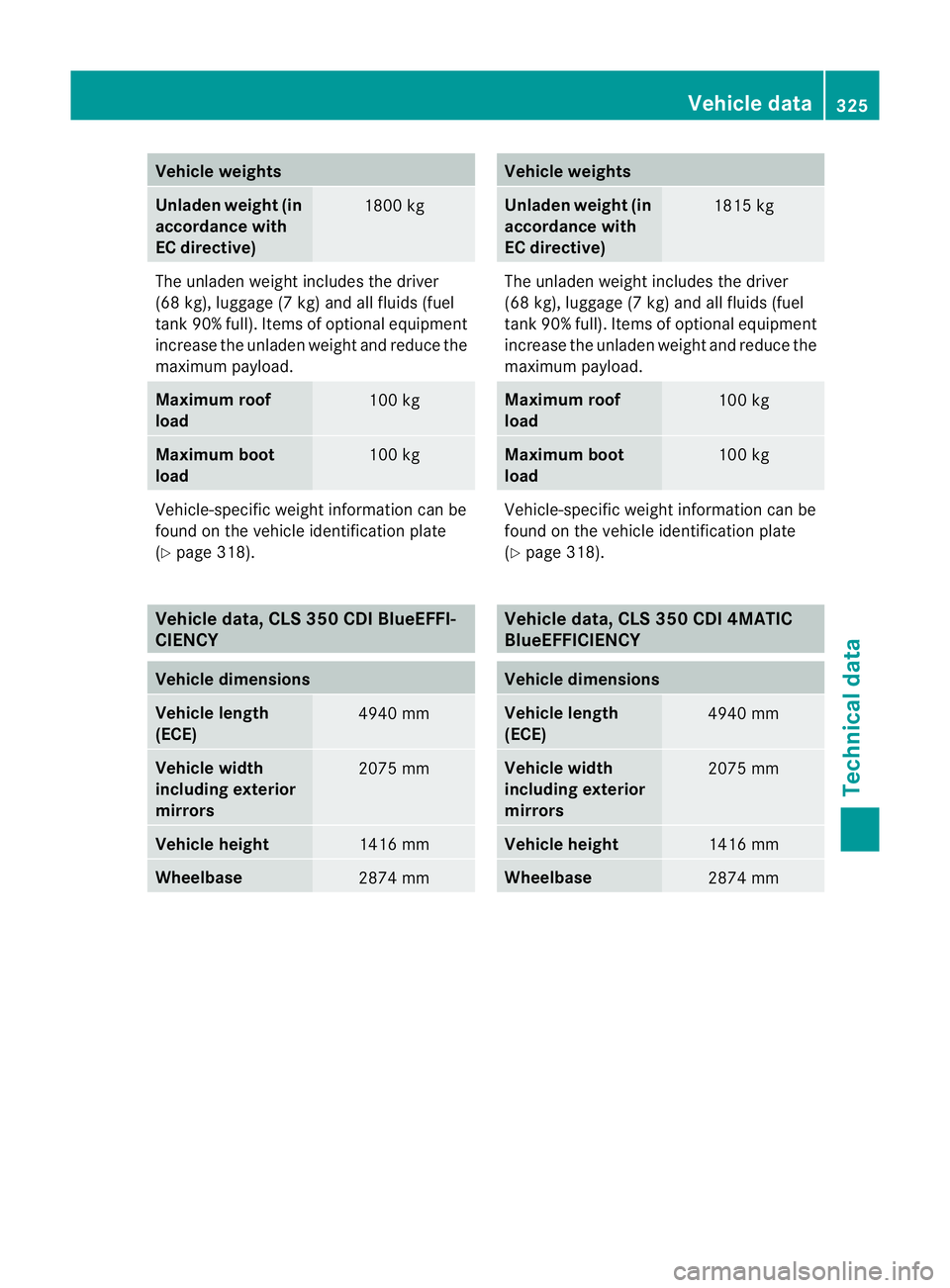
Vehicle weights
Unladen weight (in
accordance with
EC directive)
1800 kg
The unladen weight includes the driver
(68 kg), luggage (7 kg) and all fluids (fuel
tank 90% full) .Items of optional equipment
increase the unladen weight and reduce the
maximum payload. Maximum roof
load
100 kg
Maximum boot
load
100 kg
Vehicle-specifi
cweight information can be
found on the vehicle identification plate
(Y page 318). Vehicle data, CLS 350 CDI BlueEFFI-
CIENCY
Vehicle dimensions
Vehicle length
(ECE)
4940 mm
Vehicle width
including exterior
mirrors
2075 mm
Vehicle height
1416 mm
Wheelbase
2874 mm Vehicle weights
Unladen weight (in
accordance with
EC directive)
1815 kg
The unladen weight includes the driver
(68 kg), luggage (7 kg) and all fluids (fuel
tank 90% full). Items of optional equipment
increase the unladen weight and reduce the
maximum payload.
Maximum roof
load
100 kg
Maximum boot
load
100 kg
Vehicle-specific weight information can be
found on the vehicle identification plate
(Y
page 318). Vehicle data, CLS 350 CDI 4MATIC
BlueEFFICIENCY
Vehicle dimensions
Vehicle length
(ECE)
4940 mm
Vehicle width
including exterior
mirrors
2075 mm
Vehicle height
1416 mm
Wheelbase
2874 mmVehicle data
325Technical data Z
Page 329 of 337
Vehicle weights
Unladen weight (in
accordance with
EC directive)
1875 kg
The unladen weight includes the driver
(68 kg), luggage (7 kg) and all fluids (fuel
tank 90% full) .Items of optional equipment
increase the unladen weight and reduce the
maximum payload. Maximum roof
load
100 kg
Maximum boot
load
100 kg
Vehicle-specifi
cweight information can be
found on the vehicle identification plate
(Y page 318). Boot lid opening dimensions
:
Opening height :
1,628 – 1,643 mm
i
The values specified may differ from the
actual values, depending on the tyres, load,
optional equipment and the state of the
suspension. 326
Boot lid opening dimensionsTechnical data